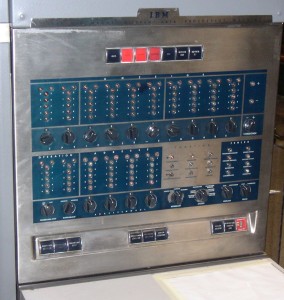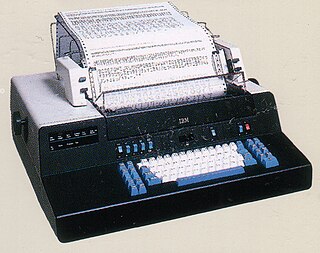The bit is a basic unit of information in information theory, computing, and digital communications. The name is a portmanteau of binary digit.
In digital logic and computing, a counter is a device which stores the number of times a particular event or process has occurred, often in relationship to a clock signal. The most common type is a sequential digital logic circuit with an input line called the clock and multiple output lines. The values on the output lines represent a number in the binary or BCD number system. Each pulse applied to the clock input increments or decrements the number in the counter.

A communication channel or simply channel refers either to a physical transmission medium such as a wire, or to a logical connection over a multiplexed medium such as a radio channel in telecommunications and computer networking. A channel is used to convey an information signal, for example a digital bit stream, from one or several senders to one or several receivers. A channel has a certain capacity for transmitting information, often measured by its bandwidth in Hz or its data rate in bits per second.

The IBM 700/7000 series is a series of large-scale (mainframe) computer systems that were made by IBM through the 1950s and early 1960s. The series includes several different, incompatible processor architectures. The 700s use vacuum tube logic and were made obsolete by the introduction of the transistorized 7000s. The 7000s, in turn, were eventually replaced with System/360, which was announced in 1964. However the 360/65, the first 360 powerful enough to replace 7000s, did not become available until November 1965. Early problems with OS/360 and the high cost of converting software kept many 7000s in service for years afterward.

A computer terminal is an electronic or electromechanical hardware device that is used for entering data into, and displaying or printing data from, a computer or a computing system. The teletype was an example of an early day hardcopy terminal, and predated the use of a computer screen by decades.

A remote terminal unit (RTU) is a microprocessor-controlled electronic device that interfaces objects in the physical world to a distributed control system or SCADA system by transmitting telemetry data to a master system, and by using messages from the master supervisory system to control connected objects. Other terms that may be used for RTU are remote telemetry unit and remote telecontrol unit.
The IBM 1800 Data Acquisition and Control System (DACS) was a process control variant of the IBM 1130 with two extra instructions, extra I/O capabilities, 'selector channel like' cycle-stealing capability and three hardware index registers.
Binary Synchronous Communication is an IBM character-oriented, half-duplex link protocol, announced in 1967 after the introduction of System/360. It replaced the synchronous transmit-receive (STR) protocol used with second generation computers. The intent was that common link management rules could be used with three different character encodings for messages. Six-bit Transcode looked backwards to older systems; USASCII with 128 characters and EBCDIC with 256 characters looked forward. Transcode disappeared very quickly but the EBCDIC and USASCII dialects of Bisync continued in use.
Queued Telecommunications Access Method (QTAM) is an IBM System/360 communications access method incorporating built-in queuing. QTAM was an alternative to the lower level Basic Telecommunications Access Method (BTAM) access method
The IBM 2780 and the IBM 3780 are devices developed by IBM to perform Remote Job Entry (RJE) functions. They communicate with the mainframe via Binary Synchronous Communications.

Decimal computers are computers which can represent numbers and addresses in decimal as well as providing instructions to operate on those numbers and addresses directly in decimal, without conversion to a pure binary representation. Some also had a variable wordlength, which enabled operations on numbers with a large number of digits.
This article presents a timeline of binary prefixes used to name memory units, in comparison of decimal and binary prefixes for measurement of information and computer storage.

IBM 3767 Communication Terminal is a serial printer terminal that employed dot matrix print-head technology and, for the first time, the Synchronous Data Link Control (SDLC) communications protocol set under IBM's Systems Network Architecture (SNA). It was introduced in 1974 and was used widely during the late 1970s to 1990s, for attachment to IBM System/360 and System/370 mainframe computers and IBM System/7 as an alternative to a 2741 typewriter terminal.
BCD, also called alphanumeric BCD, alphameric BCD, BCD Interchange Code, or BCDIC, is a family of representations of numerals, uppercase Latin letters, and some special and control characters as six-bit character codes.
270x is a generic name for a family of IBM non-programmable communications controllers used with System/360 and System/370 computers.

The IBM System/360 Model 20 is the smallest member of the IBM System/360 family announced in November 1964. The Model 20 supports only a subset of the System/360 instruction set, with binary numbers limited to 16 bits and no floating point. In later years it would have been classified as a 16-bit minicomputer rather than a mainframe, but the term "minicomputer" was not current, and in any case IBM wanted to emphasize the compatibility of the Model 20 rather than its differences from the rest of the System/360 line. It does, however, have the full System/360 decimal instruction set, that allows for addition, subtraction, product, and dividend of up to 31 decimal digits.
The Event Driven Executive (EDX) is a computer operating system originally developed by IBM for the control of research laboratory devices and experiments. It included an application programming language known as EDL and HCF, a Host Communication Facility.







